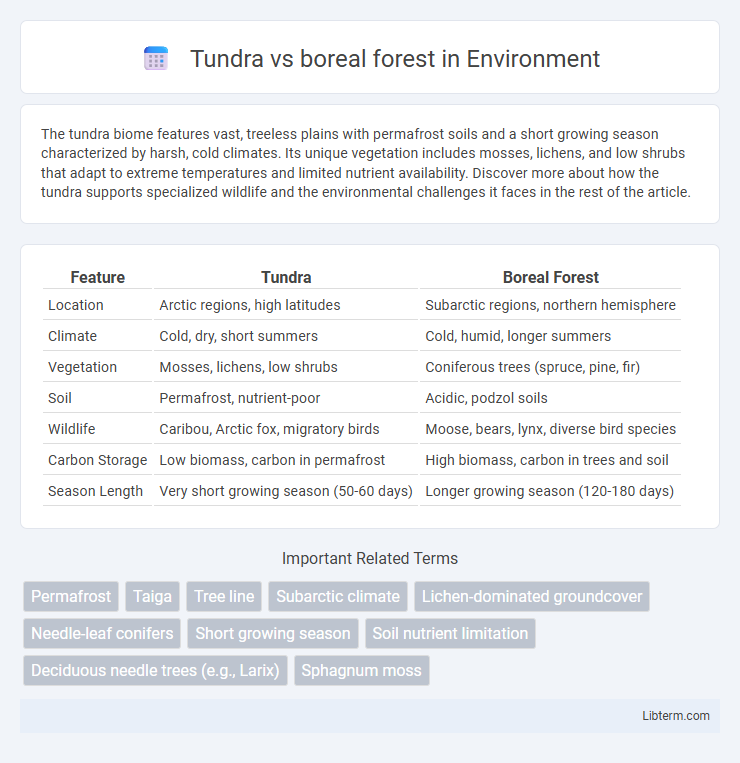The tundra biome features vast, treeless plains with permafrost soils and a short growing season characterized by harsh, cold climates. Its unique vegetation includes mosses, lichens, and low shrubs that adapt to extreme temperatures and limited nutrient availability. Discover more about how the tundra supports specialized wildlife and the environmental challenges it faces in the rest of the article.
Table of Comparison
| Feature | Tundra | Boreal Forest |
|---|---|---|
| Location | Arctic regions, high latitudes | Subarctic regions, northern hemisphere |
| Climate | Cold, dry, short summers | Cold, humid, longer summers |
| Vegetation | Mosses, lichens, low shrubs | Coniferous trees (spruce, pine, fir) |
| Soil | Permafrost, nutrient-poor | Acidic, podzol soils |
| Wildlife | Caribou, Arctic fox, migratory birds | Moose, bears, lynx, diverse bird species |
| Carbon Storage | Low biomass, carbon in permafrost | High biomass, carbon in trees and soil |
| Season Length | Very short growing season (50-60 days) | Longer growing season (120-180 days) |
Introduction to Tundra and Boreal Forest
Tundra is a cold, treeless biome characterized by permafrost, low biodiversity, and short growing seasons, primarily found in polar regions. Boreal forests, also known as taiga, consist of dense coniferous trees like spruce and fir, covering large areas of northern Canada, Russia, and Scandinavia with longer growing seasons and richer soil than tundra. Both biomes play crucial roles in global carbon storage and climate regulation, but differ significantly in vegetation, temperature, and precipitation patterns.
Geographic Distribution and Location
The tundra biome primarily spans the Arctic regions of North America, Europe, and Asia, characterized by its cold, treeless landscape often found above the Arctic Circle. The boreal forest, or taiga, extends across northern North America and Eurasia, forming a dense forest belt just south of the tundra, covering large portions of Canada, Alaska, Russia, and Scandinavia. These geographic distributions reflect distinct climatic zones, with tundra occupying colder, harsher environments, while boreal forests thrive in subarctic regions with slightly milder temperatures.
Climate Differences: Tundra vs Boreal Forest
The tundra experiences extreme cold with long, harsh winters and short, cool summers, maintaining permafrost that limits plant growth, whereas the boreal forest endures milder winters and warmer summers, allowing dense coniferous tree growth. Annual precipitation in the tundra is typically low, often less than 25 cm, compared to the boreal forest's higher precipitation ranging from 30 to 85 cm. Temperature ranges in the boreal forest fluctuate more widely, with winter averages between -15degC and -30degC and summer averages reaching 10degC to 20degC, contrasting with the tundra's consistently colder climate.
Soil Composition and Nutrient Availability
Tundra soils are typically characterized by permafrost layers that restrict drainage and lead to waterlogged conditions, causing slow organic matter decomposition and low nutrient availability. Boreal forest soils, often podzols, exhibit better drainage and more developed horizons, supporting greater microbial activity and higher nutrient cycling. The nutrient-poor, acidic nature of tundra soils contrasts with the relatively richer, yet still nutrient-limited, soils of boreal forests.
Vegetation and Plant Adaptations
Tundra vegetation consists mainly of low-growing plants such as mosses, lichens, and dwarf shrubs adapted to extreme cold and short growing seasons through antifreeze proteins and shallow root systems. Boreal forests, dominated by coniferous trees like spruce, fir, and pine, exhibit needle-like leaves coated with wax to reduce water loss and withstand harsh winters. Plant adaptations in boreal forests include thick bark for insulation and flexible branches to shed heavy snow, contrasting the tundra's focus on compact growth forms for insulation and wind resistance.
Wildlife and Animal Diversity
The tundra supports specialized wildlife such as caribou, Arctic foxes, and migratory birds adapted to extreme cold and limited vegetation. Boreal forests, or taigas, offer higher animal diversity with species like moose, lynx, wolves, and numerous bird populations due to denser tree cover and richer food sources. Wildlife in boreal forests benefits from varied habitats created by coniferous trees, while tundra animals exhibit unique adaptations to survive permafrost and short growing seasons.
Seasonal Changes and Ecological Cycles
Tundra experiences extreme seasonal changes with long, harsh winters and brief, cool summers that trigger rapid ecological cycles, including a short growing season for mosses, lichens, and low shrubs. Boreal forests undergo more moderate seasonal shifts, featuring cold winters and warm summers that support diverse tree species like spruces and pines, facilitating dynamic nutrient cycling and animal migrations. These contrasting seasonal patterns influence the carbon storage capacity and biodiversity within each biome's ecological cycles.
Human Impact and Environmental Threats
Tundra ecosystems face significant threats from climate change, leading to permafrost thaw and altered habitats, while boreal forests encounter extensive logging, mining, and increased wildfire frequency due to rising temperatures. Human activities disrupt biodiversity in both biomes, with tundra experiencing fragile soil erosion and boreal forests suffering from habitat fragmentation. These environmental stresses exacerbate carbon release, compromising the role of both tundra and boreal forests as critical carbon sinks.
Conservation Efforts and Strategies
Conservation efforts in tundra prioritize protecting fragile permafrost and native species like Arctic foxes, employing strategies such as establishing protected areas and monitoring climate change impacts. Boreal forest conservation focuses on sustainable logging practices, preserving biodiversity hotspots, and mitigating wildfire risks through controlled burns and reforestation initiatives. Both ecosystems benefit from international agreements, community engagement, and scientific research to address habitat loss and climate-related threats.
Key Similarities and Differences: Summary
Tundra and boreal forest biomes both experience cold climates and support specialized vegetation adapted to harsh conditions, including coniferous trees in boreal forests and low-growing plants in tundra. Soil in tundra is typically frozen permafrost, limiting root growth, while boreal forests have deeper, nutrient-poor but unfrozen soils. Wildlife diversity is greater in boreal forests due to the more complex habitat structure, whereas tundra hosts fewer species adapted to extreme cold and open landscapes.
Tundra Infographic

 libterm.com
libterm.com